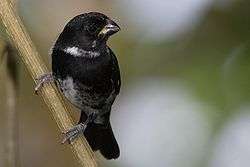Sporophila
Sporophila is a genus of Neotropical birds in the family Thraupidae. The seed finches are sometimes also included in this genus.[1]
| Sporophila | |
|---|---|
 | |
| Male variable seedeater | |
| Female | |
| Scientific classification | |
| Kingdom: | Animalia |
| Phylum: | Chordata |
| Class: | Aves |
| Order: | Passeriformes |
| Family: | Thraupidae |
| Genus: | Sporophila Cabanis, 1844 |
The genus Spermophila was introduced by the English naturalist William John Swainson in 1827.[2] The type species was subsequently designated as Temminck's seedeater (Sporophila falcirostris) by George Robert Gray in 1841.[3] As the genus name Spermophila had been introduced by John Richardson in 1825 for a genus of mammals,[4] the German ornithologist Jean Cabanis coined the present name Sporophila as a replacement in 1844.[5][6] The name combines the Ancient Greek sporos meaning "seed" and philos meaning "-loving".[7]
They are relatively small with stubby, conical bills adapted for feeding on seeds and alike. Most species are strongly sexually dimorphic, and while "typical" adult males often are distinctive, female and immatures of both sexes can be very difficult (in some species virtually impossible) to identify to exact species.[8] Females of at least some of these species have different ultraviolet colours, which can be seen by birds, but not humans.[9] Female-like (paedomorphic) males apparently also occur, at least in some species.[10]
Species
The genus contains 34 species:[11]
- Buffy-fronted seedeater, Sporophila frontalis
- Temminck's seedeater, Sporophila falcirostris
- Slate-coloured seedeater, Sporophila schistacea
- Plumbeous seedeater, Sporophila plumbea
- Tropeiro seedeater, Sporophila beltoni
- Variable seedeater, Sporophila corvina
- Grey seedeater, Sporophila intermedia (known as the Picoplat in Trinidad and Tobago)
- Wing-barred seedeater, Sporophila americana
- Caquetá seedeater, Sporophila murallae
- Cinnamon-rumped seedeater, Sporophila torqueola
- Morelet’s seedeater, Sporophila morelleti
- Rusty-collared seedeater, Sporophila collaris
- Lesson's seedeater, Sporophila bouvronides
- Lined seedeater, Sporophila lineola
- Black-and-white seedeater, Sporophila luctuosa
- Yellow-bellied seedeater, Sporophila nigricollis
- Hooded seedeater, Sporophila melanops – possibly extinct (20th century?), a hybrid or a color morph of S. nigricollis
- Dubois's seedeater, Sporophila ardesiaca – possibly a subspecies or color morph of S. nigricollis
- Double-collared seedeater, Sporophila caerulescens
- White-throated seedeater, Sporophila albogularis
- White-bellied seedeater, Sporophila leucoptera
- Parrot-billed seedeater, Sporophila peruviana
- Drab seedeater, Sporophila simplex
- Black-and-tawny seedeater, Sporophila nigrorufa
- Copper seedeater, Sporophila bouvreuil
- Pearly-bellied seedeater, Sporophila pileata
- Ruddy-breasted seedeater, Sporophila minuta
- Tawny-bellied seedeater, Sporophila hypoxantha
- Rufous-rumped seedeater, Sporophila hypochroma
- Dark-throated seedeater, Sporophila ruficollis
- Marsh seedeater, Sporophila palustris
- Chestnut-bellied seedeater, Sporophila castaneiventris
- Chestnut seedeater, Sporophila cinnamomea
- Black-bellied seedeater, Sporophila melanogaster
- Chestnut-throated seedeater, Sporophila telasco – the "Tumaco seedeater" is a stereotyped hybrid between this species and S. minuta
- Ibera seedeater, Sporophila iberaensis
References
- South American Classification Committee (2007). Incluir el género Oryzoborus dentro de Sporophila. Archived 2010-06-28 at the Wayback Machine Accessed 19 January 2010.
- Swainson, William John (1827). "On several groups and forms in ornithology, not hitherto defined". Zoological Journal. 3: 158–175, 343–363 [348].
- Gray (1841). A List of the Genera of Birds : with their Synonyma and an Indication of the Typical Species of Each Genus (2nd ed.). London: R. and J.E. Taylor. p. 63.
- Richardson, John (1825). Appendix to Captain Parry's journal of a second voyage for the discovery of a North West passage from the Atlantic to the Pacific performed in His Majesty's ships Fury and Hecla, in the years 1821-22-23. London: J. Murray. p. 313.
- Cabanis, Jean (1844). "Avium conspectus quae in Republica Peruana reperiuntur et pleraeqiio observatae vel collectae sunt in itinere a Dr. J.J. de Tschudi". Archiv für Naturgeschichte (in Latin). 10: 262–317 [291].
- Paynter, Raymond A. Jr, ed. (1970). Check-list of Birds of the World. Volume 13. Cambridge, Massachusetts: Museum of Comparative Zoology. p. 133.
- Jobling, James A. (2010). The Helm Dictionary of Scientific Bird Names. London: Christopher Helm. p. 363. ISBN 978-1-4081-2501-4.
- Ridgely, R. S., & G. Tudor (1989). The Birds of South America. Vol. 1. Univ. Texas Press, Austin
- Benites, P., Eaton, M. D., Lijtmaer, D. A., Lougheed, S. C. & Tubaro, P. L. (2010). Analysis from avian visual perspective reveals plumage colour differences among females of capuchino seedeaters (Sporophila). J. Avian Biology. 41: 597–602.
- Areta, J. I. (2009). Paedomorphosis in Sporophila seedeaters. Bull. B.O.C. 2009 129(2): 98-103.
- Gill, Frank; Donsker, David, eds. (2019). "New World warblers, mitrospingid tanagers". IOC World Bird List Version 9.2. International Ornithologists' Union. Retrieved 4 October 2019.
- Lijtmaer, D. A., N. M. Sharpe, P. L. Tubaro & S. C. Lougheed. 2004. Molecular phylogenetics and diversification of the genus Sporophila (Aves: Passeriformes). Mol. Philo. Evol. 33:562-579.
- Robbins, M. B., M. J. Braun, C. J. Huddleston, D. W. Finch, & C. M. Milensky (2005). First Guyana records, natural history, and systematics of the White-winged Seedeater (Dolospingus fringilloides). Ibis 147:334-341.